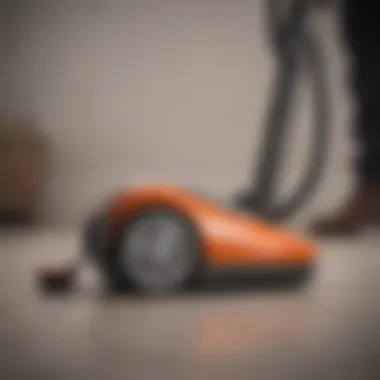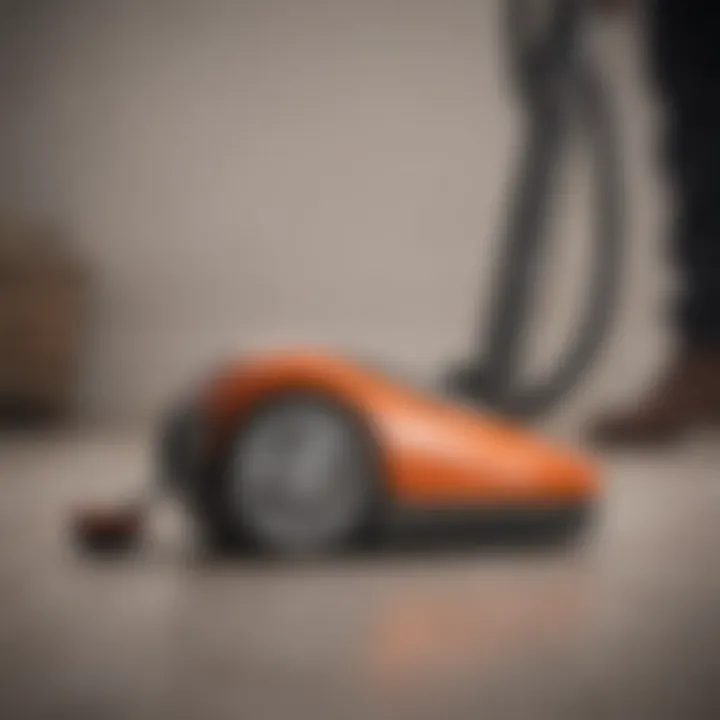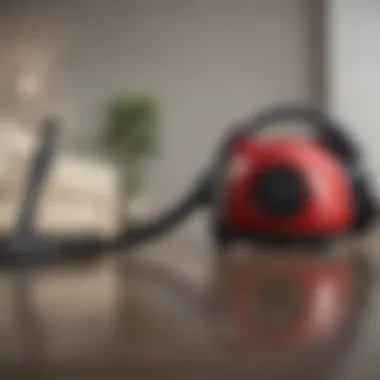Vacuum Cleaners: Effective Cleaning Without Power


Intro
The quest for clean living spaces has evolved tremendously with the introduction of various cleaning tools. Among these, vacuum cleaners hold a special position due to their efficiency and convenience. However, as energy concerns grow, many homeowners begin to explore alternatives. This includes vacuum cleaners that do not rely on electricity for their operation. Understanding these non-electric models is essential, particularly for those looking to minimize their environmental impact or reduce energy costs.
This article focuses on the functional aspects of vacuum cleaners like the broom-style or manual options, highlighting their operational mechanisms. By delving into the mechanics and effectiveness of these devices, we aim to provide insights that cater to the needs of homeowners and design enthusiasts alike, who are interested in sustainable cleaning methods.
We will also look into practical benefits and limitations regarding the use of these vacuum models in modern settings. Further, we will explore ideal scenarios for their usage. The aim is to inform readers, equipping them with knowledge that supports conscious and efficient choices in cleaning.
Preface to Non-Electric Vacuum Cleaners
Understanding non-electric vacuum cleaners is essential in today's discussions about sustainability and personal cleaning choices. As more individuals look for practical, eco-friendly solutions, these tools have regained interest. They serve as effective alternatives, especially in environments lacking accessible power sources.
Importance and Relevance
Non-electric vacuum cleaners operate based on fundamental principles of suction and motion. They do not rely on electricity and can function efficiently in various settings, whether in a small apartment or a large garden. By using force, often manually, these devices effectively collect dirt and debris without polluting the environment with energy consumption.
Many homeowners may find the idea of a non-electric vacuum appealing due to rising energy costs and concerns related to global warming. The shift towards more sustainable living is significant; adopting these old-fashioned yet practical tools could reduce reliance on electrical devices while still achieving cleanliness.
Benefits of Non-Electric Models
- Energy Efficiency: As these models don't consume electricity, they reduce energy costs and contribute to a more sustainable lifestyle.
- Portability: Lightweight and easy to store, these vacuum cleaners can be taken anywhere, making them convenient for various scenarios.
- Affordability: Often, non-electric cleaners are less expensive than their electric counterparts, allowing homeowners to save money.
Considerations
While considering a non-electric option, it's important to recognize their limitations. They may not match the cleaning efficiency of modern electric models in larger spaces. However, their ease of use and accessibility for quick clean-ups can provide a more nuanced approach to household maintenance.
In summary, non-electric vacuum cleaners offer a blend of practicality and sustainability that resonates with eco-conscious individuals. This introduction sets the stage for a deeper exploration into their forms, functions, and benefits throughout this article.
Historical Context
Understanding the historical context of non-electric vacuum cleaners provides valuable insights into their evolution and relevance in today’s cleaning methods. Non-electric models date back to a time when electricity wasn't widely available, making these tools essential for daily cleaning tasks. Their development reflects both practicality and innovation, which remains relevant in modern discussions surrounding sustainability and resource efficiency.
Origins and Development
The origins of vacuum cleaners without electricity can be traced back to the 19th century. Early designs included rudimentary devices that utilized manual effort to generate suction. Simple bellows or hand-pumped systems captured dust and debris effectively. They were particularly popular in households that prioritized cleanliness yet lacked access to a power supply or were cautious about energy consumption.
Over time, the development of these vacuum cleaners included enhancements in design and function. For instance, manual broom vacuums became a standard choice in many homes. These devices combined the functionality of sweeping with that of suction, allowing for a more thorough clean. Additionally, the fabric of the materials used began to improve. Early models often relied on basic cloth bags, while later iterations introduced more efficient filtering methods.
The development of technology also played a significant role. As insights into mechanics improved, the efficiency of non-electric vacuum cleaners increased. The adoption of innovations like the mechanical sweepers highlights how non-electric options adapted to remain relevant. Such adaptations showcase a blend of tradition and progress, ensuring they cater to diverse cleaning needs and preferences.
These early historical contexts push us to examine the modern relevance of non-electric vacuum cleaners. With the renewed focus on sustainability and energy savings, many modern homeowners find non-electric models appealing. By understanding their origins, one can appreciate the practical and eco-friendly choices available in today's market. This past informs the present and influences future designs, making the exploration of these tools essential for eco-conscious cleaning solutions.
Types of Vacuum Cleaners Without Electricity
The examination of vacuum cleaners that operate without electricity reveals a diverse umber of options available for consumers. Understanding these types is crucial for selecting the right cleaner for specific needs. They offer alternative solutions for homeowners and enthusiasts who value sustainability and functionality.
Different types range from manual tools to mechanical devices that efficiently collect dirt and debris. Their prominence lies in the re-emerging interest in eco-friendly practices and reliability in cleaning operations. Each category has distinct advantages and considerations, allowing users to choose tools that match their lifestyle and preferences.
Manual Broom Vacuums
Manual broom vacuums provide a simple yet effective way of cleaning without the need for electricity. These devices mimic the action of a traditional broom but with enhanced suction capabilities. Users push the vacuum across the floor, and its rotating brushes lift dirt and debris into a collection compartment. This type of vacuum is particularly beneficial for quick clean-ups on hard surfaces like wood or tile.
The compact and lightweight design makes it easy to store and maneuver. They are an excellent choice for environmentally conscious homeowners as they require no power source, thus reducing energy consumption. Awareness around reducing carbon footprints has led many to embrace these options, further highlighting their relevance.
Hand-Pump Models
Hand-pump models represent another category of non-electric vacuum cleaners. These devices typically feature a manual pump mechanism that creates suction when operated. Users activate the pump by pulling a handle or pushing a lever, drawing in dirt and dust as they move across surfaces.
One appealing aspect of hand-pump models is their durability. Made often with robust materials, they tend to have a longer lifespan than their electric counterparts. They are also ideal for outdoor use where electricity may not be accessible. However, their reliance on manual operation may not suit everyone, particularly those who prefer less physical effort in cleaning chores.
Corn Broom-Based Options


Corn broom-based vacuum cleaners are a unique fusion of traditional brooms and modern vacuuming technology. They utilize a corn broom head attached to a suction mechanism that captures dirt as the broom is used. This combination allows for effective gathering of debris while providing a familiar brooming action.
These options are particularly beneficial in environments with heavy debris, such as gardens or workshops. The ability to sweep and vacuum simultaneously is time-saving. However, users should be mindful of their investment as the materials and construction quality can vary, affecting efficiency.
Mechanical Sweeps
Mechanical sweeps are a more advanced option among non-electric vacuums. These devices often operate on a principle of rolling brushes combined with mechanical propulsion. As the sweeper is pushed, the brushes turn and help collect dirt and debris into a designated bin.
Mechanical sweeps are known for their effectiveness in larger areas, including parking lots or driveways, where their sweeping action covers substantial ground quickly. They can tackle a variety of surfaces like concrete or grass, making them versatile. Yet, they also require some maintenance to ensure the brushes remain effective and do not wear out.
Mechanics Behind Non-Electric Vacuuming
Understanding the mechanics behind non-electric vacuuming is essential in comprehending how these devices operate without the need for electrical power. This knowledge not only aids consumers in selecting the right type but also highlights the design and efficiency of these systems in various environments.
Principles of Suction
Suction is a fundamental principle that enables non-electric vacuum cleaners to collect dirt and debris. The effectiveness of suction relies on creating a pressure difference between the inside of the vacuum and the ambient atmosphere. Typically, non-electric models have a chamber that seals tightly against the surface being cleaned. As the user operates the device—by either pushing, pulling, or pumping—air is displaced, thus generating a vacuum.
Key factors influencing suction performance include:
- Sealing mechanism: Proper sealing allows for a stronger vacuum, enhancing dirt collection.
- Design shape: The design can streamline airflow, contributing to the effectiveness of suction.
- User effort: The force applied during operation significantly affects the suction capability. The harder one pushes or pumps, the greater the suction generated.
Understanding these principles helps users appreciate how a simple device can achieve effective cleaning without electrical dependence.
Components of Manual Vacuum Systems
Non-electric vacuum cleaners consist of several key components, each serving an integral role in their overall functionality. Examining these components helps clarify how they contribute to effective cleaning.
- Body and Housing:
- Suction Chamber:
- Sealing Components:
- Handle and Operation Mechanism:
- Filters:
- This part forms the structure of the vacuum. It helps contain the debris and supports the other components. A sturdy body is essential for longevity.
- The suction chamber is the section where dirt and debris are collected. Its size can affect the volume of debris that can be picked up during cleaning.
- Rubber or foam gaskets ensure a tight seal between the vacuum and the surface, maximizing suction efficiency.
- The handle is where the user exerts force, either by pumping or pulling. The design is critical for user comfort and efficiency.
- Some models incorporate filters that prevent fine particles from escaping, ensuring cleaner air output.
By understanding these components and their functions, consumers can better assess the performance and suitability of non-electric vacuum cleaners for their unique cleaning needs.
Advantages of Using Non-Electric Vacuum Cleaners
Non-electric vacuum cleaners offer unique benefits that are increasingly relevant in today’s eco-conscious market. Understanding these advantages is important for homeowners and design enthusiasts who seek effective solutions that don't rely on electrical power. These devices contribute not only to cleaning efficiency at home but also foster a sustainable lifestyle.
Energy Efficiency
One of the foremost advantages of non-electric vacuum cleaners is their energy efficiency. Unlike electric models that require a constant power source, non-electric options operate independently of electricity. This characteristic generates significant savings on electricity bills, especially for households that prioritize regular cleaning.
Moreover, energy conservation is a major topic in discussions regarding household appliances. Non-electric vacuum cleaners, such as manual brooms and hand-pump models, demonstrate that cleanliness does not have to come at the cost of energy waste. Consequently, users can clean their spaces without leaving a carbon footprint, making these devices ideal for the eco-minded homeowner.
Sustainability Aspects
Sustainability is essential for future generations. Non-electric vacuum cleaners align with this principle due to their low environmental impact. Many of these models utilize simple materials that can often be recycled. For example, corn broom-based options incorporate natural fibers, thus minimizing pollution that often comes with synthetic materials used in electric vacuums.
Furthermore, the longevity of non-electric models tends to be higher than their electric counterparts. With fewer mechanical components that could wear out, they provide a more sustainable option in the long run. By investing in these durable products, consumers help reduce the demand for frequent replacements that characterize electric vacuum cleaners.
"Non-electric vacuum cleaners represent a practical approach to maintaining cleanliness while promoting a sustainable lifestyle."
Portability and Convenience
Portability is another significant advantage. Non-electric vacuum cleaners are typically lightweight and easy to maneuver. For instance, hand-pump models can be efficiently carried around the house, making them suitable for quick clean-ups. Homeowners can use them in various settings, from indoors to outdoor spaces, without the need for a power outlet.


In addition, they are convenient for use in situations where electricity is unavailable, such as during power outages or outdoor events. The ease of storage, often requiring minimal space, adds to their appeal for those with limited living areas or storage concerns. Manual options can be tucked away without the clutter that comes with cords and bulky electric models.
In summary, the advantages of non-electric vacuum cleaners extend beyond just practicality. Energy efficiency, sustainability, and portability cater to a growing market that values environmental responsibility and convenience. Homeowners who explore these benefits align their cleaning habits with their eco-friendly values.
Limitations of Non-Electric Vacuum Cleaners
Understanding the limitations of non-electric vacuum cleaners is crucial in evaluating their overall efficacy. While these models offer distinct advantages in energy efficiency and sustainability, they also face certain challenges that affect their performance and user experience. By analyzing these limitations, homeowners and design enthusiasts can make more informed decisions regarding their cleaning tools.
Cleaning Efficiency Compared to Electric Models
The cleaning efficiency of non-electric vacuum cleaners often falls short when compared to electric models. One significant factor contributing to this difference is suction power. Electric vacuum cleaners utilize powerful motors that create strong suction, effectively capturing various types of debris and dirt from different surfaces. On the other hand, non-electric models rely on manual mechanisms, typically involving a pump or brush system. This design may result in less effective dirt removal, especially for stubborn particles or deep-seated dust within carpets.
Moreover, the scope of debris that non-electric vacuums can efficiently collect is limited. While they may perform admirably on hard floors and low-pile carpets, their effectiveness tends to diminish on plush carpets or rugs and in areas with heavy soiling. Homeowners with pets or children might struggle to maintain cleanliness using these models, as they often can’t handle larger messes or more intricate cleaning needs efficiently.
Usability in Different Environments
The usability of non-electric vacuum cleaners varies significantly based on environmental factors. In smaller spaces, such as apartments or compact homes, these models can be convenient and easy to maneuver. However, in larger or multi-story homes, the limitations become apparent. Users may find manual operation tedious and time-consuming, especially in extensive cleaning sessions.
Additionally, the physical effort required to operate non-electric vacuums can be considerable. For individuals with mobility issues or those requiring ergonomic solutions, the demands of using these vacuums may pose challenges. The need for constant physical engagement contrasts with electric models' ease of use, where users can cover more ground with less manual effort.
Certain environments, such as outdoor areas or highly specialized commercial settings, may also affect usability. Non-electric vacuum cleaners can be less effective in outdoor situations, where dust and debris are subject to environmental factors like wind or rain. Meanwhile, commercial settings, such as hotels or restaurants, often require cleaning equipment that can handle frequent, extensive use, further highlighting the limitations of non-electric options.
In summary, while non-electric vacuum cleaners have unique advantages, their limitations in efficiency and usability highlight the need for careful consideration when selecting cleaning tools.
Ideal Scenarios for Non-Electric Vacuum Cleaners
The relevance of non-electric vacuum cleaners increases when considering specific environments and use cases. Understanding the best scenarios for these tools helps users make informed decisions. They offer unique benefits in settings where electricity might be unavailable or impractical. The efficiency of these vacuums can be harnessed in various contexts, appealing to eco-conscious individuals and those who seek sustainable cleaning practices.
Best Suited Environments
Non-electric vacuum cleaners excel in several specific environments. Here are some key settings where their use is particularly effective:
- Off-Grid Locations: In rural areas or cabins without electricity, these vacuums provide a silent and resourceful cleaning solution.
- Gardens and Outdoor Areas: Ideal for sweeping up leaves or debris, these cleaners can be used effectively on patios and garden pathways.
- Workshops and Craft Areas: Spaces where dust and small debris accumulate can benefit from efficient non-electric vacuums without the worry of electrical hazards.
- Emergency Situations: In the event of a natural disaster that disrupts power supply, having a non-electric vacuum can be crucial in maintaining cleanliness and hygiene.
Users in these environments appreciate the simplicity and effectiveness of non-electric models, making them practical tools.
Events and Situational Use Cases
Special events and particular cleaning scenarios can also dictate the choice of non-electric vacuum cleaners. Consider the following use cases:
- Picnics and Outdoor Gatherings: After a picnic, a manual vacuum can easily pick up crumbs and small debris without needing plugs or outlets.
- Seasonal Cleaning: During the fall, collecting leaves efficiently can be managed with a non-electric vacuum designed for such tasks.
- Craft and DIY Events: After crafting sessions, these vacuums provide an easy way to clean without noisy machinery, allowing for a pleasant work environment.
- Camping: Portable non-electric options can help maintain cleanliness in tents, ensuring a comfortable camping experience.
Non-electric vacuum cleaners have a role in various settings, addressing unique needs and preferences. Their eco-friendly designs attract users who prioritize sustainability.
Comparison with Electric Vacuum Cleaners
In the realm of domestic cleaning, vacuum cleaners play a crucial role, whether they are powered by electricity or operate manually. Understanding the comparison between electric and non-electric models sheds light on their unique roles in maintaining cleanliness in homes and other spaces. While electric vacuum cleaners are often lauded for their powerful suction and convenience, non-electric alternatives provide distinct benefits worth considering.
When discussing the different models, it is vital to focus on aspects such as performance metrics and cost analysis. Evaluating performance involves looking at cleaning efficiency, noise levels, and ease of use, which are imperative for modern lifestyles. Cost analysis further enriches the discussion by comparing the initial purchase price, ongoing maintenance costs, and energy expenses. Recognizing these elements informs users about the practical implications of choosing one type over the other.
Performance Metrics
Performance metrics are a critical aspect when comparing electric vacuum cleaners and their non-electric counterparts.
- Suction Power: Electric models typically boast higher suction power, enabling them to pick up larger debris and provide a deeper clean on carpets. Conversely, non-electric vacuums rely on manual effort and design efficiencies, which can limit their suction capabilities but still prove effective for lighter, surface-level cleaning.
- Noise Levels: In contrast to their electric counterparts, non-electric vacuum cleaners generally operate more quietly. This feature can be particularly appealing to those in shared living spaces or environments where noise reduction is a priority.
- User Effort: The usability of non-electric models can vary significantly based on their design. While some are intuitive and easy to maneuver, others may require more physical effort. This fact speaks directly to user preference and their cleaning routine.
"The choice of vacuum cleaner not only affects the efficiency of cleaning but also the overall experience of maintaining a tidy environment."
Cost Analysis
Analyzing costs presents another dimension in comparing electric vacuum cleaners to non-electric versions.
- Initial Investment: Non-electric vacuum cleaners like manual broom vacuums and hand-pump models generally come at a lower initial purchase price compared to electric models. This aspect can make them more appealing for budget-conscious consumers.
- Maintenance and Durability: Electric vacuums may incur additional costs through repairs and replacements, especially as technology evolves and models become outdated. Non-electric options often have fewer components that might fail, leading to lower long-term maintenance costs.
- Energy Consumption: Non-electric models eliminate electricity costs altogether. In a society increasingly concerned with sustainability and energy efficiency, adopting a manual vacuum cleaner can provide a clear financial advantage.


In summary, while electric vacuum cleaners often outshine their manual counterparts regarding powerful suction and advanced features, non-electric models offer distinct benefits in terms of cost-effectiveness and noise reduction. As consumers evaluate their cleaning needs, these comparisons can guide them towards making informed choices.
Consumer Preferences and Trends
Understanding consumer preferences and trends regarding vacuum cleaners without electricity is vital to this discussion. As the world moves toward eco-friendliness, many homeowners are reconsidering how they clean their spaces. Non-electric vacuum cleaners offer an alternative that addresses several key concerns, including sustainability and energy efficiency.
Shifts in consumer behavior often stem from a growing awareness of the environmental impact of household products. People today are more inclined to choose cleaning solutions that use fewer resources. This trend aligns with the growing interest in reducing carbon footprints. Non-electric vacuum cleaners possess a significant niche in this evolving market, appealing to eco-conscious consumers. They serve dual purposes: maintaining cleanliness while minimizing electricity use.
Moreover, practical benefits allure users. Non-electric models are often lighter and more portable than their electric counterparts, making them easier to store and use in tight spaces. Many consumers appreciate simplicity and functionality over complex machinery. With fewer components, these devices require less maintenance, translating to savings in the long run. This aligns well with the desires of many interior design enthusiasts, who value both aesthetics and functionality in cleaning tools.
Several considerations influence consumer decisions when choosing non-electric vacuum cleaners. Cost, effectiveness, and storage are primary factors. While non-electric models may initially appear less effective, they can perform well in specific environments, particularly in simpler cleaning scenarios like small apartments or outdoor areas. Therefore, it becomes crucial for manufacturers to communicate these benefits clearly to potential buyers.
Understanding these preferences assists retailers in tailoring marketing strategies. Highlighting the eco-friendly aspect, ease of use, and cost-effectiveness appeals strongly to potential buyers. Incorporating user reviews also enhances a product's appeal, providing social proof that many seek when choosing a household tool.
In summary, the trends in consumer preferences regarding non-electric vacuum cleaners reflect a growing desire for sustainable, efficient, and practical cleaning solutions. As the market adapts to these trends, it is likely that manufacturers will continue to innovate, aligning their products with the values of environmentally conscious consumers.
Future of Non-Electric Vacuum Technology
The exploration of the future of non-electric vacuum technology is crucial in understanding how cleaning methods can evolve. With growing concerns about environmental sustainability and energy consumption, this topic gains both relevance and urgency. An increased awareness of eco-friendly products positions non-electric vacuums as compelling alternatives. Their development can lead to innovative solutions that address both basic cleaning needs and environmental considerations simultaneously.
Innovations in Design
Innovations in the design of non-electric vacuum cleaners are paving the way for more efficient systems. Manufacturers are focusing on improving suction efficiency without the need for electric power. For instance, advancements in materials mean lighter yet durable components. Also, improvements in ergonomics promote easier handling, enhancing user experience.
A few notable innovations include:
- Compact Structures: Many models now have design features that make them easier to store.
- Flexible Attachments: Modern designs often include specialized attachments for various surfaces, enhancing functionality.
- Eco-Material Usage: Designers increasingly favor sustainable resources, such as recycled plastics and biodegradable components.
These innovations not only enhance performance but also appeal to consumers seeking design-forward products that minimize their ecological footprint.
Potential for Eco-Friendly Alternatives
Exploring eco-friendly alternatives within non-electric vacuum technology indicates a promising avenue for future developments. As society shifts towards greener lifestyles, the demand for sustainable cleaning products rises. Non-electric models inherently possess the potential to reduce energy dependence.
Moreover, some non-electric vacuums can be designed to utilize natural materials that are easily recyclable. This aspect appeals to environmentally conscious consumers who prioritize sustainability in their purchasing decisions. Non-corded vacuums reduce the reliance on electricity, leading to lower carbon footprints in households.
The potential for customization in these products supports local artisans and manufacturers, encouraging community-focused initiatives. As the industry adapts, it's possible to make cleaning technologies that align not only with efficiency goals but also with collective responsibility towards the planet.
"The future of non-electric vacuum technology will likely reflect broader environmental concerns and innovations in sustainable materials."
As we proceed into this new era, the demand for non-electric vacuum cleaners will likely grow, driven by design innovations and an overarching interest in greener alternatives.
The End
The examination of vacuum cleaners without electricity highlights several significant factors that merit attention for both homeowners and environmentally-conscious consumers. Understanding the practicality and effectiveness of these alternatives can reshape perceptions about cleaning technologies and household maintenance.
Summarizing Key Points
In summary, the exploration of non-electric vacuum cleaners reveals a variety of models, including manual broom vacuums and hand-pump versions. These devices exhibit impressive energy efficiency and can be particularly beneficial in sustainable practices. Despite some limitations in cleaning performance compared to electric models, their advantages in portability and ease of use are noteworthy.
Key points to consider include:
- Energy Efficiency: Non-electric vacuum cleaners consume no power, making them a sustainable choice.
- Usability in Various Environments: Ideal for outdoor settings, such as patios and gardens, where dust and debris are common.
- Incremental Cost Savings: Initial investments are often lower without the need for electricity-driven technologies.
The discussion underscores that for many users, especially those who prioritize eco-friendly cleaning solutions, these non-electric options present an effective and practical choice. Awareness of limitations, such as reduced cleaning efficiency in larger spaces, informs better decisions when selecting tools for different environments. As awareness increases, so does the potential for innovative designs to emerge, providing even more viable options for consumers.
Importance of Citing Sources
Citing sources serves several important purposes. Firstly, it allows readers to verify the information presented, ensuring transparency and trustworthiness. Secondly, incorporating expert opinions and data lends weight to the claims made in the article. This is particularly vital when discussing the effectiveness and usability of non-electric vacuum cleaners. When homeowners and design aficionados seek out non-electric options, they require assurance that these alternatives match or exceed their electric counterparts in certain aspects.
Elements of a Strong Reference Section
- Diversity of Sources: Including a mix of scholarly articles, commercial evaluations, and user testimonials can provide a comprehensive view. For instance, insights from Reddit forums can reflect real-world experiences of users.
- Relevance: Each reference must directly relate to the topic at hand, ensuring it supports the arguments made. It is critical for homeowners to understand not just how these cleaners work but the experiences of others who utilize them.
- Current Data: In a rapidly evolving market, using up-to-date references is essential. The importance of eco-friendly alternatives is at an all-time high; thus, sourcing the latest materials will resonate with the audience's needs.
"Knowledge has no value unless you can apply it; references guide you towards that application."
Considerations for Using References
- Bias: It is important to be mindful of the potential bias in sources, especially from manufacturers attempting to promote their own products. Analyzing a range of perspectives can help mitigate this concern.
- Accessibility: Ensure references are accessible so that readers can delve deeper into the material if they wish. Providing links to relevant articles increases engagement and trust.
- Structured Format: Adopting a consistent format for references enhances readability, making it easier for the audience to digest information.















